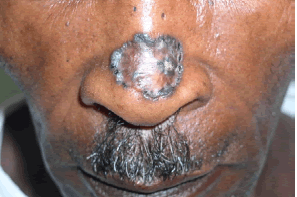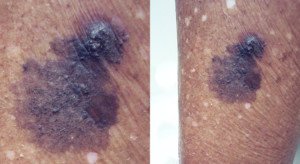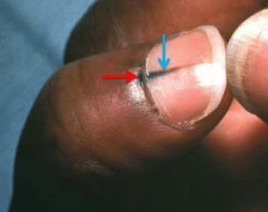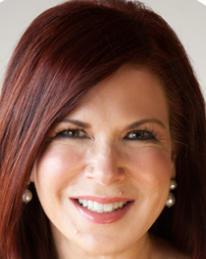Don’t let the media’s portrayal of skin cancer patients fool you.
Blacks and other dark skinned people need to do monthly self-exams because they too can get any of the three major skin cancers:
• Basal cell carcinoma (BCC)
• Squamous cell carcinoma (SCC)
• Melanoma
All three tumors can occur in people with deep olive or caramel skin, even darker tones.
Media Portrayal of Skin Cancer Victims Is Misleading
Yes, very light skin that never tans, blue eyes, freckles, red hair and/or Northern European ancestry are risk factors for melanoma.
But just like those with pale skin, light eyes and blonde hair can live a long life without getting skin cancer, those with African ancestry DO get diagnosed with melanoma, squamous cell carcinoma and basal cell carcinoma.

Skin cancer on the nose of a black male. omicsonline.org
Never mind that awareness campaigns, pamphlets, print and online articles almost always show a stereotypical victim of skin cancer (either a model or a real-life patient) who is European-looking with fair skin.
“The media can be misleading in its representation of who is at risk for skin cancer,” says Vivian Bucay, MD, with the Bucay Center for Dermatology and Aesthetics, an integrative dermatology practice in San Antonio, TX.
“The fact is that anyone can get skin cancer, regardless of race or skin color,” continues Dr. Bucay.
“Although individuals with black skin are less likely to develop skin cancer, the truth is that a diagnosis of melanoma in those with black skin is usually delayed, meaning that the skin cancer is usually more advanced and will therefore have worse prognosis because the delay in diagnosis has given it more time to spread to other areas.”
What Skin Cancer in Blacks Looks Like

Melanoma; J Am Acad Dermatol. 2006;55(5):741-60

Squamous cell carcinoma on leg

Nail melanoma
Blacks and other dark skinned men and women absolutely should do self-skin exams every month.
This means check your moles every month in addition to the rest of your skin.
Whether of African, Latino, Southeast Asian, Pacific Islander or Middle Eastern heritage, you should make a date with your skin every month and conduct self-exams.
Get to know your moles, but also keep on the lookout for any new spots or lesions.
Dr. Bucay also says, “Acral melanomas, which are located on the hands and feet, including the nails, are more common [than in whites] in the African American and Hispanic/Latino populations.”
In fact, melanoma of the nail (subungual melanoma) occurs significantly more often in blacks, Latinos, Asians and Native Americans than in Caucasians.
Where on dark skin can melanoma arise?
According to one study of 96 African Americans with melanoma (Krementz et al, Department of Surgery, Tulane University School of Medicine):
- Face
- Lip
- Trunk
- Palm
- Finger
- Thigh
- Lower leg
- Top and bottom of foot. For both men and women, the sole of the foot had the most melanomas.
Though skin cancer overall in African Americans is uncommon, their survival rate is much lower than in Caucasians — due to a low suspicion index leading to a delayed diagnosis.
A dark toned person, influenced by the media portrayal of skin cancer, may notice a new growth or lesion — yet never consider that it might be malignant.
The tumor will only progress, eventually becoming worrisome enough to the patient to make a doctor appointment. By then, the tumor cells may have already infiltrated lymph nodes.
All three cancers are highly curable when caught early, which is why the monthly self-exam is so crucial.
In addition, it’d be wise to have a dermatologist examine you every year, since some areas of the body are difficult to self-examine.
Should Blacks Live in Fear of Skin Cancer?
Of course not. Just do the monthly skin exams as part of your overall health regimen.
SCC is slower growing, but can spread and be fatal if the diagnosis is late.
BCC is extremely slow growing and VERY RARELY spreads. However, when neglected, it causes local destruction, which can include bone and soft tissue.
A black person who has a lot of moles and lives at high altitude, and spends a lot of time in the sun without sunscreen, already has three risk factors for melanoma. Those risk factors don’t care how dark your skin is.
Even if people of dark complexion don’t have the above risk factors, SCC or BCC that crops up in middle age and even beyond can be the result of excessive sun exposure during CHILDHOOD.
It can take decades for the sun-damaged cells to transform into a malignancy.
Furthermore, nail melanoma is not related to sun exposure, and the biggest risk factor is dark skin.
Thus, your monthly skin cancer exam should include a thorough inspection of your fingernails and toenails.
 In private practice since 1991, Dr. Bucay has been a keynote speaker across the globe on a wide scope of topics ranging from innovations in facial aesthetics to evidence-based skin care to cancer survival.
In private practice since 1991, Dr. Bucay has been a keynote speaker across the globe on a wide scope of topics ranging from innovations in facial aesthetics to evidence-based skin care to cancer survival.
 Lorra Garrick has been covering medical, fitness and cybersecurity topics for many years, having written thousands of articles for print magazines and websites, including as a ghostwriter. She’s also a former ACE-certified personal trainer.
Lorra Garrick has been covering medical, fitness and cybersecurity topics for many years, having written thousands of articles for print magazines and websites, including as a ghostwriter. She’s also a former ACE-certified personal trainer.
.










































